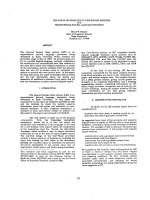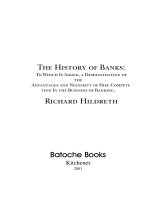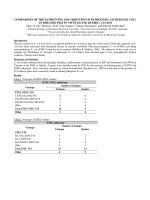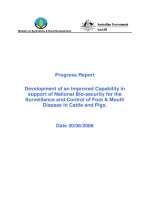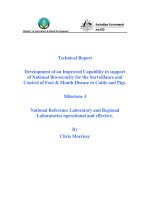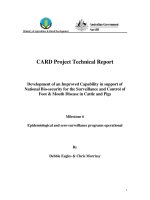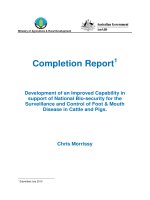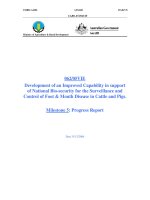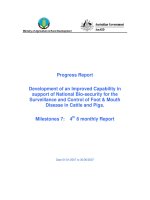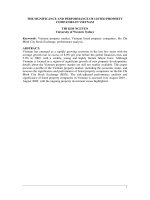The transmission and processing of sensor rich videos in mobile environment
Bạn đang xem bản rút gọn của tài liệu. Xem và tải ngay bản đầy đủ của tài liệu tại đây (4.01 MB, 164 trang )
THE TRANSMISSION AND PROCESSING OF
SENSOR-RICH VIDEOS IN MOBILE
ENVIRONMENT
HAO JIA
B.E., HIT, CHINA
A THESIS SUBMITTED
FOR THE DEGREE OF DOCTOR OF
PHILOSOPHY
SCHOOL OF COMPUTING
NATIONAL UNIVERSITY OF SINGAPORE
2013
Declaration
I hereby declare that this thesis is my original work and it has been
written by me in its entirety. I have duly acknowledged all the sources of
information which have been used in the thesis.
This thesis has also not been submitted for any degree in any university
previously.
HAO Jia 30 Oct 2013
a
c
2013
HAO Jia
All Rights Reserved
Dedication
This thesis is dedicated to
my beloved sister and friend,
Hao Ming,
my beloved parents,
Hao Peigang and Li Deying,
who gave me unconditional support and love all my life.
c
Acknowledgements
This thesis is the result of five years of work during which I have been ac-
companied and supported by many people. Without them, the completion
of my thesis would not have been possible. It is now my great pleasure to
take this opportunity to thank them.
First and foremost, I would like to express my most profound gratitude
to my supervisor, Prof. Roger Zimmermann, for his guidance and support.
It has been an invaluable experience working with him in the past five years.
His insights, suggestions and guidance helped me sharpen my research skills
and his inspiration, patience and encouragement helped me conquer the
difficulties and complete my Ph.D. program successfully. It has been a
great honor for me to be his student.
My gratitude and appreciation to my advisory and examining commit-
tee Prof. Wang Ye, Prof Ooi Wei Tsang, and Prof. Pung Hung Keng, for
their invaluable assistance, feedback and patience at all stages of this thesis.
Their criticisms, comments, and advice were critical in making this thesis
more accurate, more complete and clear to read. I also would like to thank
the School of Computing, National University of Singapore for providing
me the opportunity to do doctoral research with financial support.
My sincere thanks go out to Dr. Seon Ho Kim, Dr. Beomjoo Seo and
Dr. Sakire Arslan Ay with whom I have collaborated during my Ph.D.
research. Their conceptual and technical insights into my research work
have been invaluable.
I want to express my sincere appreciation to my dear colleagues Liang
Ke, Ma He, Shen Zhijie, Zhang Ying, Ma Haiyang, Cui Weiwei, Wang
Guanfeng and Yin Yifang in Media Management Research Lab. We have
experienced a lot together and move forward with each other. I also want
to thank my dearest friends in NUS: Chen Qi, Deng Fanbo, Lu Meiyu,
Ma He, Wang Xiaoli, Yang Xin and Zhang Meihui. I am grateful for the
encouragement and enlightenment they gave to me. They accompanied me
to overcome the most difficult period and make my life wonderful.
Last, but definitely not the least, I would like to thank my family for
their love and support. None of my achievements would be possible without
their love and encouragement.
d
Publications
Peer Reviewed
• Jia Hao, Seon Ho Kim, Sakire Arslan Ay and Roger Zimmermann.
Energy-Efficient Mobile Video Management using Smartphones. In
Proceedings of the 2
th
ACM Multimedia Systems Conference (ACM
MMSys), February 2011.
• Jia Hao, Guanfeng Wang, Beomjoo Seo and Roger Zimmermann.
Keyframe Presentation for Browsing of User-generated Videos on
Map Interface. In Proceedings of the 19
th
annual ACM International
Conference on Multimedia (ACM MM), November 2011.
• Beomjoo Seo, Jia Hao and Guanfeng Wang. Sensor-rich Video Explo-
ration on a Map Interface. In Proceedings of the 19
th
annual ACM In-
ternational Conference on Multimedia (ACM MM), November 2011.
• Jia Hao, Roger Zimmermann and Haiyang Ma. GTube: Geo-Predictive
Video Streaming over HTTP in Mobile Environment. In the 5
th
ACM
Multimedia Systems Conference (ACM MMSys), March 2014.
Under Review
• Jia Hao, Guanfeng Wang, Beomjoo Seo and Roger Zimmermann.
Point of Interest Detection and Visual Distance Estimation for Sensor-
rich Video. In IEEE TMM, 2014.
• Ke Liang, Jia Hao, Roger Zimmermann and David Y.C. Yau. Inte-
grated Prefetching and Caching for Adaptive Streaming over HTTP:
An Online Approach. In IEEE ICDCS, 2014.
Patent
• Roger ZIMMERMANN, Seon Ho KIM, Sakire ARSLAN AY, Beomjoo
SEO, Zhijie SHEN, Guanfeng WANG, Jia HAO, Ying ZHANG. “AP-
PARATUS, SYSTEM, AND METHOD FOR ANNOTATION OF
MEDIA FILES WITH SENSOR DATA” WIPO Patent APPLICA-
TION No. 2012115593. 31 Aug. 2012.
e
CONTENTS
Summary v
List of Figures vii
List of Tables x
1 Introduction 1
1.1 Background and Motivations . . . . . . . . . . . . . . . . . . 1
1.2 Research Work and Contributions . . . . . . . . . . . . . . . 4
1.2.1 Energy-Efficient Video Acquisition and Upload . . . . 4
1.2.2 Point of Interest Detection and Visual Distance Es-
timation . . . . . . . . . . . . . . . . . . . . . . . . . 6
1.2.3 Keyframe Presentation of User Generated Videos on
a Map Interface . . . . . . . . . . . . . . . . . . . . . 7
1.2.4 Geo-Predictive Video Streaming . . . . . . . . . . . . 8
1.3 Organization . . . . . . . . . . . . . . . . . . . . . . . . . . 9
1.4 Terminology Definitions . . . . . . . . . . . . . . . . . . . . 9
2 Literature Review 13
2.1 Energy Management on Mobile Devices . . . . . . . . . . . . 13
2.1.1 System-Level Energy Management . . . . . . . . . . 14
2.1.2 Application-Level Energy Management . . . . . . . . 16
2.1.3 Summary . . . . . . . . . . . . . . . . . . . . . . . . 17
i
CONTENTS
2.2 Geo-Referenced Digital Media . . . . . . . . . . . . . . . . . 19
2.2.1 Techniques for Geo-referenced Images . . . . . . . . . 19
2.2.2 Techniques for Geo-referenced Videos . . . . . . . . . 20
2.2.3 Commercial Products . . . . . . . . . . . . . . . . . . 22
2.2.4 Video Sensor Networks . . . . . . . . . . . . . . . . . 22
2.2.5 Summary . . . . . . . . . . . . . . . . . . . . . . . . 23
2.3 Geo-Location Mining . . . . . . . . . . . . . . . . . . . . . . 24
2.3.1 Mining Location History . . . . . . . . . . . . . . . . 24
2.3.2 Landmark Mining from Social Sharing Websites . . . 25
2.4 Video Presentation . . . . . . . . . . . . . . . . . . . . . . . 25
2.4.1 Keyframe Extraction . . . . . . . . . . . . . . . . . . 25
2.4.2 Video Summarization . . . . . . . . . . . . . . . . . . 26
2.4.3 Summary . . . . . . . . . . . . . . . . . . . . . . . . 26
2.5 Adaptive HTTP Streaming . . . . . . . . . . . . . . . . . . . 27
2.5.1 HTTP Streaming Fundamentals . . . . . . . . . . . . 27
2.5.2 Quality Adaptation in Adaptive HTTP Streaming . . 28
2.5.3 Location-Aided Video Delivery Systems . . . . . . . . 29
2.5.4 Summary . . . . . . . . . . . . . . . . . . . . . . . . 30
3 Energy-Efficient Video Acquisition and Upload 31
3.1 Introduction . . . . . . . . . . . . . . . . . . . . . . . . . . . 31
3.2 Power Model . . . . . . . . . . . . . . . . . . . . . . . . . . 32
3.2.1 Modeled Hardware Components . . . . . . . . . . . . 32
3.2.2 Analytical Power Model . . . . . . . . . . . . . . . . 33
3.2.3 Validation of the Power Model . . . . . . . . . . . . . 34
3.3 System Design . . . . . . . . . . . . . . . . . . . . . . . . . . 36
3.3.1 Data Acquisition and Upload . . . . . . . . . . . . . 37
3.3.2 Data Storage and Indexing . . . . . . . . . . . . . . . 38
3.3.3 Query Processing . . . . . . . . . . . . . . . . . . . . 39
3.4 Experimental Evaluation . . . . . . . . . . . . . . . . . . . . 40
3.4.1 Simulator Operation . . . . . . . . . . . . . . . . . . 40
3.4.2 Simulator Architecture and Modules . . . . . . . . . 42
3.4.3 Experiments and Results . . . . . . . . . . . . . . . . 45
3.5 Prototype . . . . . . . . . . . . . . . . . . . . . . . . . . . . 55
3.5.1 Android Geo-Video Application . . . . . . . . . . . . 55
ii
CONTENTS
3.5.2 User Interface . . . . . . . . . . . . . . . . . . . . . . 58
3.6 Summary . . . . . . . . . . . . . . . . . . . . . . . . . . . . 59
4 Point of Interest Detection and Visual Distance Estimation 60
4.1 Introduction . . . . . . . . . . . . . . . . . . . . . . . . . . . 60
4.2 Approach Design . . . . . . . . . . . . . . . . . . . . . . . . 62
4.2.1 POI Detection . . . . . . . . . . . . . . . . . . . . . . 62
4.2.2 Effective Visual Distance Estimation . . . . . . . . . 67
4.3 Experiments . . . . . . . . . . . . . . . . . . . . . . . . . . . 69
4.3.1 Data Collection . . . . . . . . . . . . . . . . . . . . . 69
4.3.2 Results . . . . . . . . . . . . . . . . . . . . . . . . . . 73
4.3.3 Discussion . . . . . . . . . . . . . . . . . . . . . . . . 85
4.4 Summary . . . . . . . . . . . . . . . . . . . . . . . . . . . . 86
5 Keyframe Presentation for Browsing of Videos on Map In-
terfaces 88
5.1 Keyframe Extraction . . . . . . . . . . . . . . . . . . . . . . 89
5.1.1 Visual Similarity Measurement . . . . . . . . . . . . 89
5.1.2 Keyframe Selection . . . . . . . . . . . . . . . . . . . 91
5.2 Experiments . . . . . . . . . . . . . . . . . . . . . . . . . . . 93
5.2.1 Keyframe Extraction Results . . . . . . . . . . . . . 93
5.2.2 Keyframe Placement Results . . . . . . . . . . . . . . 98
5.3 Prototype . . . . . . . . . . . . . . . . . . . . . . . . . . . . 99
5.3.1 System Architecture . . . . . . . . . . . . . . . . . . 99
5.3.2 Demonstration . . . . . . . . . . . . . . . . . . . . . 100
5.4 Summary . . . . . . . . . . . . . . . . . . . . . . . . . . . . 102
6 GTube: Geo-Predictive Video Streaming 103
6.1 Introduction . . . . . . . . . . . . . . . . . . . . . . . . . . . 103
6.2 System Design . . . . . . . . . . . . . . . . . . . . . . . . . . 105
6.2.1 Geo-Bandwidth Data Collection and Upload . . . . . 106
6.2.2 Geo-Bandwidth Query and Response . . . . . . . . . 108
6.2.3 Quality Adaptation . . . . . . . . . . . . . . . . . . . 112
6.3 Evaluation . . . . . . . . . . . . . . . . . . . . . . . . . . . . 117
6.3.1 Datasets . . . . . . . . . . . . . . . . . . . . . . . . . 117
6.3.2 Experimental Setup . . . . . . . . . . . . . . . . . . . 119
iii
CONTENTS
6.3.3 Evaluation Metrics . . . . . . . . . . . . . . . . . . . 120
6.3.4 Experimental Results . . . . . . . . . . . . . . . . . . 122
6.3.5 Discussion . . . . . . . . . . . . . . . . . . . . . . . . 130
6.4 Summary . . . . . . . . . . . . . . . . . . . . . . . . . . . . 130
7 Conclusions 132
7.1 Summary of Research . . . . . . . . . . . . . . . . . . . . . . 132
7.2 Limitations . . . . . . . . . . . . . . . . . . . . . . . . . . . 133
7.3 Future Work . . . . . . . . . . . . . . . . . . . . . . . . . . . 135
Bibliography 138
iv
CONTENTS
Summary
The astounding volume of camera sensors produced for and embedded in
cellular phones has led to a rapid advancement in their quality, wide avail-
ability and popularity for capturing, uploading and sharing of videos (also
referred to user-generated content or UGC). Furthermore, GPS-enabled
smartphones have become an essential contributor to location-based ser-
vices. A large number of geo-tagged photos and videos have been accumu-
lating continuously on the web, posing a challenging problem for mining
this type of media data. Existing solutions attempt to examine the sig-
nal content of the videos and recognize objects and events. This is typi-
cally time-consuming and computationally expensive and the results can
be uneven in their quality. Therefore these methods face challenges when
applied to large video repositories. Furthermore, the acquisition and trans-
mission of large amounts of video data on mobile devices face fundamental
challenges such as power and wireless bandwidth constraints. To support
diverse mobile video applications, it is critical to overcome these challenges.
Recent technological trends have opened another avenue that fuses
much more accurate, relevant data with videos: the concurrent collec-
tion of sensor-generated geospatial contextual data. The aggregation of
multi-sourced geospatial data into a standalone meta-data tag allow video
content to be identified by a number of precise, objective geospatial charac-
teristics. These so-called sensor-rich videos can conveniently be captured
with smartphones. In this thesis we investigate the transmission and pro-
cessing of sensor-rich videos in mobile environment. Our work focuses on
the following key issues for sensor-rich videos:
1) Energy-efficient video acquisition and upload. We design a system to
support energy-efficient sensor-rich video delivery. The core of our approach
is the separate transmission of the small amount of text-based geospatial
meta-data from the large binary-based video content.
2) Point of Interest (POI) detection and visual distance estimation. We
propose a technique which is able to detect interesting regions and objects
and their distances from the camera positions in a fully automated way.
3) Presentation of user generated videos. We present a system that pro-
vides an integrated solution to present videos based on keyframe extraction
and interactive, map-based browsing.
v
CONTENTS
4) Geo-predictive video streaming. We present a method to predict the
bandwidth change for HTTP streaming. The method makes use of the
geo-location information to build bandwidth maps to facilitate bandwidth
prediction, and efficient quality adaptation. We also propose two quality
adaptation algorithms for adaptive HTTP streaming.
Our study shows that using location and viewing direction information,
coupled with timestamps, efficient video delivery systems can be developed,
more interesting information can be mined from video repository, and user-
generated video presentation can be more natural.
vi
LIST OF FIGURES
1.1 Mobile video will generate over 66 percent of mobile data
traffic by 2017 [20]. . . . . . . . . . . . . . . . . . . . . . . . 2
1.2 The framework of sensor-rich video transmission and pro-
cessing. . . . . . . . . . . . . . . . . . . . . . . . . . . . . . . 5
2.1 Classification of the related work. . . . . . . . . . . . . . . . 14
2.2 Illustration of FOV in 2D space. . . . . . . . . . . . . . . . . 21
2.3 Dynamic Adaptive Streaming of HTTP (DASH) system. . . 27
3.1 Screenshot of the Android PowerTutor app. . . . . . . . . . 34
3.2 Comparison of the results from the power model with logs
from PowerTutor. . . . . . . . . . . . . . . . . . . . . . . . . 36
3.3 System environment for energy-efficient sensor-rich video de-
livery. . . . . . . . . . . . . . . . . . . . . . . . . . . . . . . 36
3.4 The block diagram of the simulator architecture. . . . . . . . 42
3.5 Spatial query distribution with three different clustering pa-
rameter values h. . . . . . . . . . . . . . . . . . . . . . . . . 44
3.6 Node lifetimes (i.e., energy efficiency), result completeness,
and query response latency with N = 2, 000 nodes. . . . . . 46
3.7 Energy consumption and access latency with varying meta-
data upload period (1/λ
s
). . . . . . . . . . . . . . . . . . . . 48
3.8 Energy consumption with varying location data collection
scheme. . . . . . . . . . . . . . . . . . . . . . . . . . . . . . 49
vii
LIST OF FIGURES
3.9 Energy consumption and average query response latency
with varying FOV and Network topology generator param-
eters. . . . . . . . . . . . . . . . . . . . . . . . . . . . . . . . 51
3.10 Energy consumption and average query response latency
with varying query model parameters. . . . . . . . . . . . . 52
3.11 Total transmitted data size as a function of various query
model parameters. . . . . . . . . . . . . . . . . . . . . . . . 53
3.12 The overall energy consumption and query response latency
when using a hybrid strategy with both Immediate and On-
Demand as a function of the switching threshold (h = 0.5). . 54
3.13 Geo-Video Android application prototype. . . . . . . . . . . 58
4.1 Flowchart of the proposed approach. . . . . . . . . . . . . . 61
4.2 (a) Conceptual illustration of visual distance estimation. (b)
Illustration of the detection of a non-existent “phantom” POI. 63
4.3 (a) Sector-based coverage model. (b) Center-line-based cov-
erage model. . . . . . . . . . . . . . . . . . . . . . . . . . . . 65
4.4 Distribution of horizontal POI position within a video frame
for two videos V
8636
and V
1477
in Fig. 4.13 (0 – left margin,
50 – center, 100 – right margin). . . . . . . . . . . . . . . . . 66
4.5 Screenshots of acquisition software for Android-based and
iOS-based smartphones used in the experiments. . . . . . . . 70
4.6 GPS error distribution for Singapore dataset. . . . . . . . . 72
4.7 POI detection results of the cluster-based method (Singapore). 73
4.8 POI detection results for sector-based coverage model with
the grid-based method (Singapore). . . . . . . . . . . . . . . 74
4.9 POI detection results for center-line-based coverage model
with the grid-based method (Singapore). . . . . . . . . . . . 75
4.10 POI detection results of the grid-based method (Chicago). . 77
4.11 POI detection results of the cluster-based method (Chicago). 78
4.12 Computation time of two methods with varying number of
FOVs. . . . . . . . . . . . . . . . . . . . . . . . . . . . . . . 79
4.13 Center line vector sequences for videos V
8636
and V
1477
. . . . 80
viii
LIST OF FIGURES
4.14 Comparison between the ground truth and the estimated
visual distance R for video V
8636
(the frame sequence number
is labeled on top of the selected frames). . . . . . . . . . . . 83
4.15 Comparison between the ground truth and the estimated
visual distance R for video V
1477
(the frame sequence number
is labeled on the selected frames). . . . . . . . . . . . . . . . 84
5.1 Flowchart of the proposed keyframe extraction algorithm. . . 90
5.2 Overlap ratio of the projected line between two FOVs. . . . 90
5.3 The number of keyframes as a function of the threshold T
using video v8636. . . . . . . . . . . . . . . . . . . . . . . . 93
5.4 Selected keyframes of video v8636 for two keyframe selection
algorithms. . . . . . . . . . . . . . . . . . . . . . . . . . . . 94
5.5 Visual similarity scores and keyframe identification results
for video v8636. . . . . . . . . . . . . . . . . . . . . . . . . . 95
5.6 Video preview based on effective visible distance estimation. 98
5.7 Server-side processes and data flow. . . . . . . . . . . . . . . 100
5.8 A sample screen-shot taken during playback. . . . . . . . . . 101
6.1 Flowchart of the proposed geo-predictive GTube streaming
system. . . . . . . . . . . . . . . . . . . . . . . . . . . . . . . 105
6.2 Illustration diagram of bandwidth prediction (k = 3). . . . . 109
6.3 An example of a bandwidth map for the NUS campus. . . . 118
6.4 GPS error distribution for GPS trace dataset. . . . . . . . . 119
6.5 Bandwidth statistics for a single location at different times
of 7 days. . . . . . . . . . . . . . . . . . . . . . . . . . . . . 122
6.6 Evaluation results for path prediction and bandwidth pre-
diction. . . . . . . . . . . . . . . . . . . . . . . . . . . . . . . 124
6.7 Video quality level for four algorithms for Track 1. . . . . . . 126
6.8 Video quality level for four algorithms for Track 2. . . . . . . 127
6.9 Cumulative distribution function of quality. . . . . . . . . . 128
6.10 Video quality level for different N values obtained from the
N-predict algorithm (Track 2). . . . . . . . . . . . . . . . . . 129
ix
LIST OF TABLES
1.1 Table of abbreviations. . . . . . . . . . . . . . . . . . . . . . 11
1.2 Summary of symbolic notations. . . . . . . . . . . . . . . . . 12
2.1 Typical energy consumption distribution in a smartphone
with multimedia capabilities [90]. . . . . . . . . . . . . . . . 15
2.2 Energy management techniques in mobile systems. . . . . . 18
2.3 Geo-referenced digital media . . . . . . . . . . . . . . . . . . 24
3.1 Parameters of the HTC G1 smartphone used in the power
model. . . . . . . . . . . . . . . . . . . . . . . . . . . . . . . 32
3.2 β-parameters under different operational modes. . . . . . . . 35
3.3 Simulation parameters (values in bold are the default settings). 40
3.4 Android audio/video capture parameters. . . . . . . . . . . . 56
4.1 Statistics of the two datasets. . . . . . . . . . . . . . . . . . 71
4.2 Comparison between two POI detection methods. . . . . . . 78
4.3 Absolute and relative error distribution of the estimated vi-
sual distance R. . . . . . . . . . . . . . . . . . . . . . . . . . 85
5.1 The keyframes, extracted by IMARS and by our approach,
are evaluated by mean opinion score (MOS). . . . . . . . . . 97
6.1 Parameters used in the experiments (values in bold are the
default settings). . . . . . . . . . . . . . . . . . . . . . . . . 119
x
LIST OF TABLES
6.2 Ratio of bandwidth utilization (higher numbers are better). 125
6.3 Rate of video quality level shift (lower numbers are better). 125
xi
CHAPTER 1
Introduction
1.1 Background and Motivations
The influx of affordable, portable, and networked video cameras has made
various video applications feasible and practical. Furthermore, the com-
bination of mobile cameras with other sensors has extended plain video
sensor networks to wireless multimedia sensor networks (WMSNs). These
are expected to be capable of managing far more and diverse information
from the real world because videos with associated scalar sensor data can
be collected, transmitted, and searched to more effectively support a wide
range of multimedia applications. These include both conventional and
emerging ones such as multimedia surveillance, environmental monitoring,
industrial process control, and location based multimedia services [5]. As
a result, various mobile devices, sensors, networks, and multimedia search
schemes have been designed and tested to implement such systems.
Traditionally, any comprehensive sensor network has been constructed
with expensive, custom hardware and network architecture for specific ap-
plications leading to limited use. Nowadays, demand for portable comput-
ing and communication devices has been increasing rapidly. Mobile devices
are increasingly popular for users to capture, upload and share videos. As
wireless connectivity is integrated into many handheld devices, streaming
multimedia content among mobile peers is becoming a popular applica-
1
CHAPTER 1. INTRODUCTION
tion. Mobile data traffic, according to an annual report from Cisco [20],
continues to grow significantly due to recent strong market acceptance of
smartphones and tablet computers. The forecast also estimates that global
mobile data traffic will reach 11.2 exabytes per month (134 exabytes an-
nually); growing 13-fold from 2012 to 2017. Figure 1.1 shows that mobile
video traffic – already consisting of half of the total mobile network traffic
– will account for two-thirds by the year 2017.
0
6
12
2012
2013
2014
2015
2016
2017
Mobile File Sharing (3.5%)
Mobile M2M (5.1%)
Mobile Web/ Data (24.9%)
Mobile Video (66.5%)
Exabytes per Month
66% CAGR 2012-2017
Figures in legend refer to traffic share in 2017.
Source: Cisco VNI Mobile Forecast, 2013
Figure 1.1: Mobile video will generate over 66 percent of mobile data traffic
by 2017 [20].
However, the acquisition and transmission of large amounts of video
data on mobile devices face fundamental challenges such as power and wire-
less bandwidth constraints. Furthermore, the search and presentation of
large video databases still remains a very challenging task. Mobile stream-
ing suffers from discontinuous playback which affect the user perceived
Quality of Service (QoS). To support diverse mobile video applications, it
is critical to overcome these challenges.
There are currently two prevalent methods to make video content
searchable. First, there is a significant body of research on content-based
video retrieval, which employs techniques that extract features based on
the visual signals of a video. While progress has been very significant in
2
CHAPTER 1. INTRODUCTION
this area, achieving high accuracy with this approach is difficult. For ex-
ample, this method is often limited to specific domains such as sports or
news content, and applying them to large-scale video repositories creates
significant scalability problems. The second method utilizes searchable text
annotations embedded in video content; however high-level concepts must
often be added manually and embedded text annotations can be ambiguous
and subjective.
Recent technological trends have opened another avenue that fuses
much more accurate, relevant data with videos: the concurrent collec-
tion of sensor-generated geospatial contextual data. The aggregation of
multi-sourced geospatial data into a standalone meta-data tag allow video
content to be identified by a number of precise, objective geospatial charac-
teristics. These so-called sensor-rich videos can conveniently be captured
with smartphones. Importantly, the recorded sensor-data streams enable
processing and result presentation in novel and useful ways.
Location is one of the important cues when people are retrieving rel-
evant videos. A search keyword often can be interpreted as a point or
regional location in the geo-space. Some types of video data are natu-
rally tied to geographical locations. For example, video data from traffic
monitoring may not have much meaning without its associated location
information. Thus, in such applications, one needs a specific location to
retrieve the traffic video at that point. Hence, combining video data with
its location information can provide an effective way to index and search
videos, especially when a database handles an extensive amount of video
data.
For mobile video delivery, network condition can be predicted based
on the history data in the same location. Bandwidth maps [98] can be built
with location and network throughput information. Afterwards, one can
predict the future bandwidth by using bandwidth maps.
Current-generation smartphones have GPS receivers, compasses, and
accelerometers all embedded into a small, portable, energy-efficient pack-
age. When aggregated, the resulting meta-data can provide a comprehen-
sive and easily identifiable model of a video’s viewable scene, which can
support scalable organization, search, and streaming of large scale video
repositories.
3
CHAPTER 1. INTRODUCTION
In the presence of such meta-data, a wide range of novel applications
can be developed. However, there are still many open, fundamental re-
search questions in this field. Most videos captured are not panoramic and
as a result the viewing direction becomes very important. GPS data only
identifies object locations and therefore it is imperative to investigate the
natural concepts of a viewing direction and a view point. For example, the
location of the most salient object in the video is often not at the position of
the camera, but may in fact be quite a distance away. Consider the example
of a user videotaping the pyramids of Giza – he or she would probably need
to stand at a considerable distance. The question arises whether a video
database search can accommodate such human friendly views. Cameras
may also be mobile and thus the concept of a camera location is extended
to a trajectory. Therefore, unlike still images a single point location will not
be adequate to describe the geographic region covered in the video. The
continuous evolvement of cameras’ location, viewing direction and other
sensor data should be modeled and stored in the video database.
Researchers have only recently started to investigate and understand
the implications of the trends brought about by technological advances
in sensor-rich video. There is tremendous potential that has yet to be
explored.
1.2 Research Work and Contributions
In this thesis we focus on how to efficiently transmit, process and present
the sensor-rich videos. Figure 1.2 illustrates the proposed framework. We
will next discuss each of these issues in more details.
1.2.1 Energy-Efficient Video Acquisition and Upload
Employing smartphones as the choice of mobile devices, we propose a new
approach to support energy-efficient mobile video capture and their trans-
mission [44]. Based on the important observation that not all collected
videos have high priority (i.e., many of them will not be requested and
viewed immediately), the core of our approach is to separate the small
amount of text-based geospatial meta-data of concurrently captured video
4
CHAPTER 1. INTRODUCTION
a) Energy- efficient
Video Acquisition
and Upload
b) POI Detection and
Visual Distance Estimation
c) Keyframe Presentation
on a Map Interface
d) Geo-Predictive
Video Streaming
Video Server
Acquisition Device
and Software
Mobile Client
Figure 1.2: The framework of sensor-rich video transmission and process-
ing.
content from the large binary-based video content. This small amount of
meta-data is then transmitted to a server in real-time, while the video con-
tent will remain on the recording device, creating an extensive, resource
efficient catalogue of video content, searchable by viewable scene proper-
ties established from meta-data attached to each video. Should a particular
video be requested, only then will it be transmitted from the camera to the
server in an on-demand manner (preferably, only the relevant segments, not
the entire videos). The delivery of unrequested video content to a server
can be delayed until a faster connection is available.
The main contributions of this work are listed as follows:
• Saving bandwidth. Our strategy of uploading the sensor informa-
tion in real-time while transmitting the bulky video data on demand
later reduces the transmission of uninteresting videos. The total data
transmitted from mobile device to server can be reduced up to 81.6%
in our experiments. Therefore by applying this strategy, the wireless
network transmission burden can be reduced.
• Reducing energy consumption. Videos will be uploaded only
5
CHAPTER 1. INTRODUCTION
when they are requested, therefore the energy consumption for wire-
less transmission can be reduced (about 21.1% in our experiments).
This operation substantially prolongs the device usage time while
ensuring a low search latency.
1.2.2 Point of Interest Detection and Visual Distance
Estimation
We present our unique and unconventional solution to address three impor-
tant challenges in mobile video management: (1) how to find interesting
places (Point of Interest - POI) in user-generated sensor-rich videos, (2) how
to leverage the viewing direction together with the GPS location to identify
the salient objects in a video, and (3) how to efficiently estimate the visual
distance to objects in a video frame. We do not restrict the movement of
the camera operator (for example to a road network) and hence assume
that mobile videos may be shot along a free-moving trajectory. At first, to
obtain a viewable scene description, we continuously collect GPS location
and viewing direction information (via a compass sensor) together with the
video frames. Then the collected data are sent via the wireless network to
server. This is practically achievable today as smartphones contain all the
necessary sensors for recording videos that are annotated with meta-data.
On the server side, in the first stage we process the sensor meta-data of
a collective set of videos to identify POIs containing important objects or
places. The second stage computes a set of visual distances R between the
camera locations and the POIs. Finally, the obtained POI and R are ready
for other usage.
Our method is complementary to other approaches while it also has
some specific strengths. Methods that use content-based analysis, such
as Google Goggles, require distinctive features of known landmarks (i.e.,
structures). For example, Goggles may not be able to recognize a famous
lake because of a lack of unique features. Our approach crowd-sources “in-
teresting” spots automatically. Our POI estimation is not solely designed
to be a standalone method. We take advantage of using existing land-
mark databases if available. There exists considerable research literature
on detecting landmark places from photos. Compared to prior studies, ours
6
CHAPTER 1. INTRODUCTION
differs in the following aspects:
• Accurate POI detection. We identify the location of interesting
places that appear in users’ videos, rather than the location where
the user was standing, holding the camera.
• Automaticity. The proposed technique is fully automatic. It also
does not require any training set.
• Scalability. The approach is scalable to large video repositories as
it does not rely on complex video signal analysis, but rather leverages
the geographic properties of associated meta-data, which can be done
computationally fast.
POI detection can be useful in a number of application fields such
as providing video summaries for tourists, or as a basis for city planning.
Additionally, automatic and detailed video tagging can be done and even
simple video search can benefit.
1.2.3 Keyframe Presentation of User Generated Videos
on a Map Interface
To present user-generated videos that relate to geographic areas for easy ac-
cess and browsing, it is often natural to use maps as interfaces. A common
approach is to place thumbnail images of video keyframes in appropriate
locations. Here we consider the challenge of determining which keyframes
to select and where to place them on the map.
We present a system that provides an integrated solution to present
videos based on keyframe extraction and interactive, map-based brows-
ing [45, 91]. As a key feature, the system automatically computes popular
places based on the collective information from all the available videos. For
each video it then extracts keyframes and renders them at their proper loca-
tion on the map synchronously with the video playback. All the processing
is performed in real-time, which allows for an interactive exploration of all
the videos in a geographic area.
The main contributions of this work are listed as follows:
• Automaticity. The proposed technique is fully automatic and re-
quires no manual intervention.
7
CHAPTER 1. INTRODUCTION
• Scalability. The method is highly scalable since its processing is
performed on the meta-data, which is small in size relative to the
video data.
• Real-time. Our keyframe extraction method is very suitable to be
executed near real-time – extract keyframe while the video is still
being captured, the reasons are: 1) the algorithm does not assume a
fixed number of keyframes in advance; instead, it selects keyframes
appropriate for the actual video content 2) it does not need the
global information about the video content 3) the computation is
light-weight because of the use of metadata.
1.2.4 Geo-Predictive Video Streaming
We propose an approach for geo-predictive video streaming: GTube. We
develop a smartphone application to gather network information and re-
late it to a certain location given by the GPS. The information collected is
used to create the coverage and bandwidth database that will be used to
build the bandwidth map. For estimating the future network condition, a
path prediction and a geo-based bandwidth estimation method is presented
that utilize the bandwidth map. Finally, we provide two quality adaptation
algorithms which make use of the predicted bandwidth obtained in the pre-
vious step. The proposed scheme enables the mobile client to intelligently
use the location-specific bandwidth information in making quality adapta-
tion decisions. Overall, the solution achieves a balance between resource
demands and quality of service.
The list of itemized contributions for this work are as follows:
• Quick adaptation. Our approach can help streaming application
to achieve fast and smooth adaptation to the varying network condi-
tions.
• Improved bandwidth utilization. Our approach provides higher
bandwidth utilization (up to 93.3%).
• Guaranteed QoE. Our approach is effective to achieve continuous
playback, thus guaranteeing the user perceived quality of experience.
8
